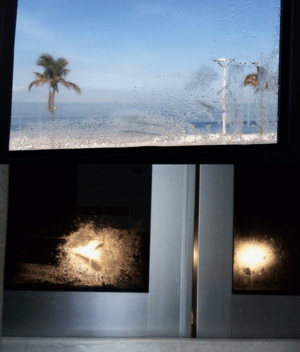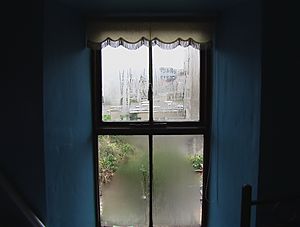Condensation facts for kids
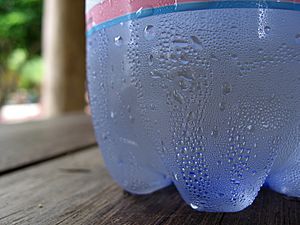
Condensation is the process in which gas changes into a liquid when it touches a cooler surface, so the state of matter is being changed. Condensation is an important part of the water cycle. It is the opposite of evaporation.
Contents
Process
Condensation of water is when water changes from gas to a liquid or crystal shape. Any gas can condensate, usually at a low temperature or high pressure. However, condensation can technically happen at any temperature, as long as the pressure of the condensing gas is more than the pressure of the liquid state of that gas (both at the same temperature).
During condensation, the molecules in the matter slow down. Heat energy is taken away, causing the state of matter to change.
Condensation is vital in nature and is always the same as temperature and vapour pressure in nature. This means that if there is a lot of condensation, the temperature goes up. Alternatively, if there is hardly any condensation, there will be a temperature loss.
It is a useful process. One use is in the creation of “new water” (drinkable water made from drinkable sources). However, since there is a temperature gain when a lot of condensation happens, the heat may need to be "removed".
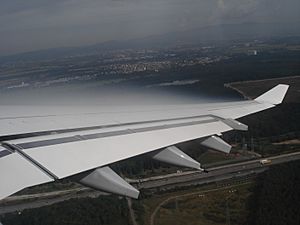
Initiation
Condensation is initiated by the formation of atomic/molecular clusters of that species within its gaseous volume—like rain drop or snow flake formation within clouds—or at the contact between such gaseous phase and a liquid or solid surface. In clouds, this can be catalyzed by water-nucleating proteins, produced by atmospheric microbes, which are capable of binding gaseous or liquid water molecules.
Reversibility scenarios
A few distinct reversibility scenarios emerge here with respect to the nature of the surface.
- absorption into the surface of a liquid (either of the same substance or one of its solvents)—is reversible as evaporation.
- adsorption (as dew droplets) onto solid surface at pressures and temperatures higher than the species' triple point—also reversible as evaporation.
- adsorption onto solid surface (as supplemental layers of solid) at pressures and temperatures lower than the species' triple point—is reversible as sublimation.
Most common scenarios
Condensation commonly occurs when a vapor is cooled and/or compressed to its saturation limit when the molecular density in the gas phase reaches its maximal threshold. Vapor cooling and compressing equipment that collects condensed liquids is called a "condenser".
Measurement
Psychrometry measures the rates of condensation through evaporation into the air moisture at various atmospheric pressures and temperatures. Water is the product of its vapor condensation—condensation is the process of such phase conversion.
Applications of condensation
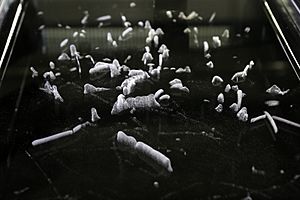
Condensation is a crucial component of distillation, an important laboratory and industrial chemistry application.
Because condensation is a naturally occurring phenomenon, it can often be used to generate water in large quantities for human use. Many structures are made solely for the purpose of collecting water from condensation, such as air wells and fog fences. Such systems can often be used to retain soil moisture in areas where active desertification is occurring—so much so that some organizations educate people living in affected areas about water condensers to help them deal effectively with the situation.
It is also a crucial process in forming particle tracks in a cloud chamber. In this case, ions produced by an incident particle act as nucleation centers for the condensation of the vapor producing the visible "cloud" trails.
Commercial applications of condensation, by consumers as well as industry, include power generation, water desalination, thermal management, refrigeration, and air conditioning.
Biological adaptation
Numerous living beings use water made accessible by condensation. A few examples of these are the Australian thorny devil, the darkling beetles of the Namibian coast, and the coast redwoods of the West Coast of the United States.
Condensation in building construction
Condensation in building construction is an unwanted phenomenon as it may cause dampness, mold health issues, wood rot, corrosion, weakening of mortar and masonry walls, and energy penalties due to increased heat transfer. To alleviate these issues, the indoor air humidity needs to be lowered, or air ventilation in the building needs to be improved. This can be done in a number of ways, for example opening windows, turning on extractor fans, using dehumidifiers, drying clothes outside and covering pots and pans whilst cooking. Air conditioning or ventilation systems can be installed that help remove moisture from the air, and move air throughout a building. The amount of water vapor that can be stored in the air can be increased simply by increasing the temperature. However, this can be a double edged sword as most condensation in the home occurs when warm, moisture heavy air comes into contact with a cool surface. As the air is cooled, it can no longer hold as much water vapor. This leads to deposition of water on the cool surface. This is very apparent when central heating is used in combination with single glazed windows in winter.
Interstructure condensation may be caused by thermal bridges, insufficient or lacking insulation, damp proofing or insulated glazing.
Table
|
To
From
|
Solid | Liquid | Gas | Plasma |
|---|---|---|---|---|
| Solid | Melting | Sublimation | ||
| Liquid | Freezing | Vaporization | ||
| Gas | Deposition | Condensation | Ionization | |
| Plasma | Recombination |
See also
 In Spanish: Condensación (cambio de estado) para niños
In Spanish: Condensación (cambio de estado) para niños


